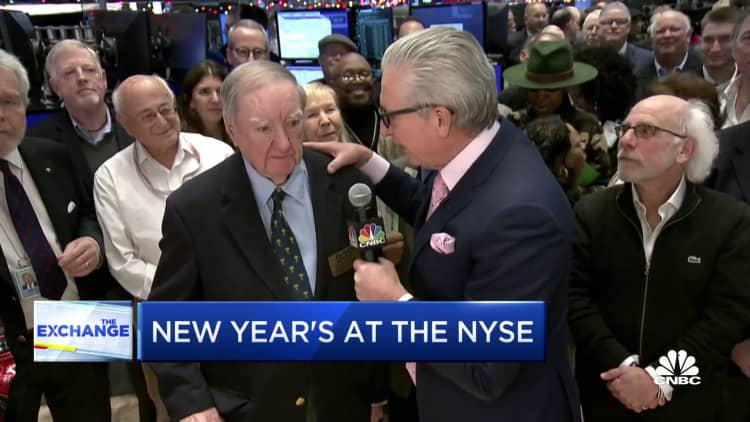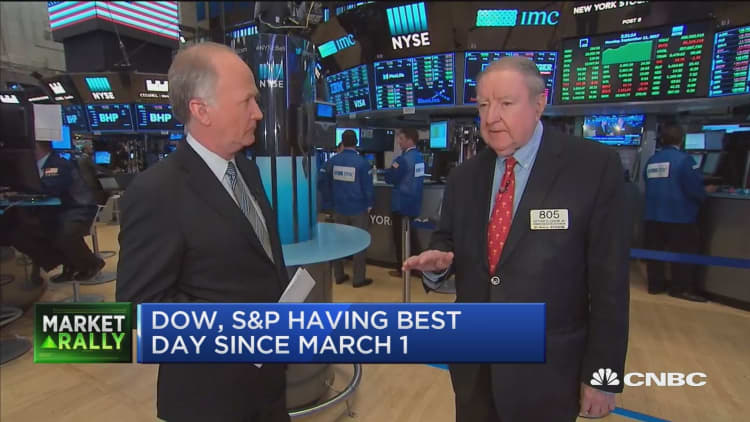# Art Cashin, New York Stock Exchange fixture for decades, dies at age 83

Art Cashin, UBS' director of floor operations at the New York Stock Exchange and a man The Washington Post called "Wall Street's version of Walter Cronkite," has died. He was 83 and had been a regular on CNBC for more than 25 years.
In the intensely competitive and often vicious world of stock market commentary, Cashin was that rarest of creatures: a man respected by all, bulls and bears, liberals and conservatives alike. He seemed to have almost no enemies.
He was a great drinker and raconteur, a teller of stories.
For decades, he assembled a group of like-minded friends every day after trading halted, first at the bar at the NYSE luncheon club, then across the street at Bobby Van's Steakhouse, where the group came to be known as the "Friends of Fermentation." His drink was Dewar's, always on the rocks.

Cashin's success was attributable to a combination of charm, wit, intelligence, and a stubborn insistence on refusing to adopt many of the conveniences of the modern world. He was a link to an NYSE tradition. Every year, on Christmas Eve and New Year's Eve, he led the singing of the 1905 song "Wait 'Till the Sun Shines, Nellie."
Cashin refused to use credit cards and paid for everything, particularly his voluminous bar bills, with cash, saying he cherished his anonymity. He never learned to use a computer — his notes were hand-written and then sent to his assistant. For years, he used an obsolete flip phone that he rarely answered.
His desk was piled high with papers he had accumulated over the decades. At times, it resembled a recycling facility.
Cashin's suits were usually rumpled and his ties were always obsolete.

However, neither his appearance nor his attitude was haphazard. They were part of a persona that was carefully constructed over more than 50 years on Wall Street.
Arthur D. Cashin Jr. was born in Jersey City, New Jersey, in 1941. His parents were superintendents of an apartment building. His business career began in 1959 at Thomson McKinnon, a brokerage firm, when he was 17 and still in high school. Cashin had been obliged to join the workforce when his father died unexpectedly that year.
Art Cashin and CNBC's Bob Pisani discuss the stock market from the floor of the NYSE in 2013.
In 1964, at age 23, he became a member of the NYSE and a partner of P.R. Herzig & Co.
At that time, the vast majority of all trading took place on the NYSE floor. Cashin's early memories revolve around the noise of thousands of brokers shouting at each other. He claimed to be able to tell if the market was moving up or down by the pitch of the screaming, because sellers sounded panicky. "And so if the pitch of the noise was high, I would know the sellers were headed my way. Or if it was a rumble, I would know that it was probably buyers coming," he said in a 2018 interview.
In the mid-1970s, disgusted by the corruption in his hometown of Jersey City, Cashin ran for mayor. "I think I ran 12th in a field of five," he said. "But once they discovered I was honest, there wasn't much chance I was going to get elected."
He returned to Wall Street. In 1980, he joined PaineWebber and managed its floor operation, continuing to do so after PaineWebber was bought by UBS in 2000.
Then came 2001.
Cashin would often recall what it was like to escape from Ground Zero on Sept. 11, 2001, after terrorists crashed two jetliners into the World Trade Center towers, killing more than 2,600 people in the heart of the nation's financial center.
"Many of us got out that Tuesday walking through streets onto which ash, smoke and business envelopes fell snow-like, blocking both your view and your breathing," [he wrote in a commentary 13 days later.](http://www.cmgwealth.com/wp-content/uploads/2015/09/Art-Cashin-Sept-11-2015.pdf) "Yet when a stranger was met, they were invited to join the convoy and offered a spare wet cloth (carried in pockets) through which to breathe as they walked. When we reached the East River (Brooklyn side of Manhattan), there was a volunteer group of tugboats, fishing boats and mini-ferries that looked like the evacuation of Dunkirk. No charge. No money. Just — "May I help you!" No one got anyone's name. No thank you cards will be sent. But Americans — even New York Americans — who freely give to strangers but argue with neighbors were suddenly one group. In the days since, as we wander via new strange ways back to Wall Street, we all internalize the survivor's quandary. We are lucky to be alive — but why us."

After the Sept. 11 attacks, Cashin chaired the NYSE "Fallen Heroes Fund," which provided millions of dollars to the families of first responders killed in the line of duty.
Though he was a respected market historian, he was most renowned as a storyteller for the stock market. He was a meticulous observer of fundamental and technical trading patterns but never let data get in the way of explaining the market in a folksy manner that made it accessible to even casual observers. He often spoke of Wall Street as a community of people with many different opinions. In his world, the bulls and bears would fight it out every day, as if it were all a John Wayne Western: "The bulls are circling the wagons, trying to defend the highs" was a common refrain.
Art Cashin, managing director at UBS Financial Services, speaks to CNBC in 2019.
CNBC
His daily market commentary, Cashin's Comments, was distributed to clients continuously for more than 40 years and was widely read on Wall Street. It invariably began with an analysis of an important event that occurred on that date ("On this date in 1918, the worldwide flu epidemic went into high gear in the U.S."), and after a brief history lesson tied that event to the day's market events ("Pre-opening Wednesday morning, U.S. stock futures looked like they might be coming down with the flu. Several earnings reports were less than glowing and some of the outlooks were cloudy").
He was a keen observer of human behavior, a behavioral psychologist long before the word was coined. He had seen his fellow humans panic time after time, and had seen the effects of succumbing to the initial desire to sell immediately without thinking. "It tells me that people have a tendency to overreact — and to not think things through carefully," he said. "And you break up, again, into two sets of people, those who look with some suspicion at events, and others who say, 'Oh, I've got to react to that.' Those who react immediately rarely do well. Those who are somewhat suspect, they do much better."
He had two great loves in his life: his family and the New York Stock Exchange. In the age of computerized trading, the fabled NYSE trading floor still survives, though in greatly diminished form. When it was closed during the Covid pandemic, he said he was "[disappointed ... but it was understandable](https://www.cnbc.com/2020/04/05/nyse-legend-art-cashin-gives-his-first-comments-on-the-coronavirus-sell-off-and-when-we-recover.html)."
Art Cashin with Santa Claus on the floor of the NYSE in 2013.
NYSE
Cashin was philosophical when asked about the rise of electronic trading, which has slowly but surely eroded the influence of that floor. "I miss those magnificent days when your spirit hung on the fact that you were good for your word or you're outta here," he once said at Bobby Van's, but admitted that electronic trading had improved the speed and accuracy of trading, particularly recordkeeping.
Among his many friends, he will perhaps be best remembered for his modesty. He seemed genuinely puzzled about his popularity. "People have an interest in — in Arthur Cashin. I can't fully understand why," he said.
And when The Washington Post ran a long profile of his career in 2019, calling him Wall Street's version of CBS newsman Cronkite, he quipped: "I think I owe an apology to Walter Cronkite."
*In lieu of flowers, the family kindly requests donations be made to the Arthur D. Cashin Jr. Memorial Scholarship at Xavier High School. Contributions may be sent to Xavier High School, 30 West 16th Street, New York, NY 10011.*
*— CNBC's* [*Martin Steinberg*](https://www.cnbc.com/marty-steinberg/) *contributed to this report.*